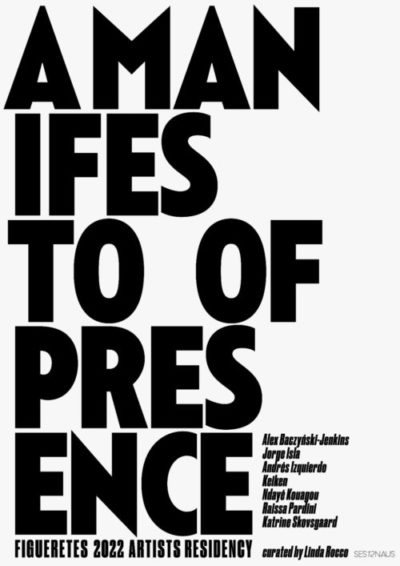
A manifesto OF PRESENCE
Curatorial text for Figueretes residency 2022
The economy of presence in the contemporary art scene relentlessly demands artists to be present for exclusive events, as a surplus accessory to the work. Alluding to the notorious Marina Abramovic performance: The Artist Is Present – and it seems that it must increasingly be so. Whether a Private View, a Q&A or a presentation at a fair, artists are demanded to perform as such in established social contexts – distant from a classical view of the artist as an alone, tormented entity in a lightly-dim studio.
In a residency format, the artist’s presence extends over time, causing rhetorics of exclusivity to collapse. Particularly when presence is a given, it equals performing permanent availability, and labour blurs into everyday life. The collapsing of time between work, life, and everything in between, was a desire shared by a great number of artists working across the world in the 1960s. Yet in a hyper-mediated 21st-century society, this romantic fascination is expressed through freelance low pay contracts and precarious working schemes, which lead artists to exhaustion, burnouts, and little inspiration.
The demand for immediacy and total presence is a neoliberal consequence of technology. According to MIT Professor William T. Mitchell, the economy of presence is characterised by a ‘technologically enhanced market for attention, time, movement – a process of investment that requires careful choices. The point is that technology gives you tools that allow for remote and delayed presence, so that physical presence becomes the scarcest option among a range of alternatives’*.
With social media and smart working we are now used to exercise multiple forms of presence and required to be in many places simultaneously. It is not only about being present but also about showing that you are there. The politics of visibility are a complex mechanism intertwined with belonging and acceptance: If you are not there, you are missing out. And if you are there, you have to show everyone that you are – otherwise, it never happened.
A fundamental concept in Heidegger philosophy is dasein, which translates to ‘being there’ or ‘presence’ in German. That ‘being there’ is not specifically connected to a particular space-time but it’s instead a state of mind pointing to what is possible, what can be actuated or realised. In describing the fundamentals of dasein, Heidegger adds the locution ‘with’, to define the inextricable relation to other human beings and utensils, as the world around us is both natural and man-made. According to Heidegger, artists, poets and thinkers as such, more than anyone else, feel threatened by the omnipotence of object-ness and its instrumental purpose. The distress of our times is precisely the lack of questioning, of awareness of being. He points to art as the only way out from the supreme certainty of daily life, where language and information dictate our being in the world.
Figueretes 2022 residency, as an experiment into modes of being present, reflects upon artists being present within the everyday life of Ibiza. Allowing them time to reflect, share and come together – in an attempt at dialoguing with the societal fabric of the island over two months. Some artists have done this directly by getting into people’s houses or talking to locals. Others have subtly explored their own positioning, intimately looking for the meanings and effects of their practice. Some artists stayed across the entire two months, others had to leave in-between and exercise presence by proxy through the mediation of digital devices.
Andrés Izquierdo interrogated the halo of spirituality covering the island, looking into ancient histories that were once there and have become myths throughout the centuries. The geological sedimentation of presence, and knowledge — perpetuated through orality and symbolism — manifests in the wilderness of the untouched nature. Still inspired by nature yet through a critique of the contemporary condition, artist Jorge Isla questioned the exuberant presence of tourism and globalisation on the island that morphs identity over seasons. Isla looked into invasive natural species as a metaphor to tackle the role of commercialisation and capitalism that spoils the sacred land. Choreographer Alex Baczynski-Jenkins explored presence through movement, whilst Raissa Pardini examines the auditory presence of the island. Not what the world commonly associates with Ibiza – the sounds of its clubs – but instead the authentic and quiet sounds, echoes and noises, that exist within the fabric of the island and its local traditions. Artist Ndayé Kouagou analysed presence through words. Both his own and the one gathered from meeting with locals and young people. Exuberant on the eye yet deeply subtle and intimate, presence here is a fleeting comment, a whispered thought. Katrine Skovsgaard embraced the enactment of presence through touch. Witnessing the practice of those working with their hands, ceramicists, farmers, physicians, tattoo artists, to capture local stories of intimacy and care. The collective Keiken explored notions of presence beyond the real world, using technology as a tool to develop holistic visions of the future and alternative ways of being.
This Manifesto expands across three different dimensions and beyond words, to include abstract multimedia contributions. The exhibition space where the artists’ work fully realises in its physical form; the page as a 2D space and the digital dimension where further research and contributions from the audience assemble online.
*William T. Mitchell, ETopia: Urban Life, Jim, But Not As We Know It (Cambridge, MA: MITPress, 1999)
Originally published on https://www.ses12naus.org/en/manifesto/